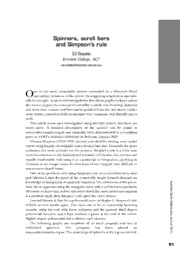
ERIC EJ717790: Spinners, Scroll Bars and Simpson's Rule PDF
Preview ERIC EJ717790: Spinners, Scroll Bars and Simpson's Rule
Spinners, scroll bars and Simpson’s rule Ed Staples Erindale College, ACT <[email protected]> One of the most remarkable devices embedded in a Microsoft Excel spreadsheet is known as the spinner. Its staggering simplicity is undoubt- edly its strength. As an incrementing device that allows graphs to dance across the screen, it gives the concept of variability a whole new meaning. Spinners and their close cousins scroll bars can be grabbed from the view menu (under tools, forms), placed tactfully in amongst your equations, and playfully put to work. This article is one such investigation using the little critters, but there are many more. A detailed description of the spinner can be found at www.canberramaths.org.au and examples were demonstrated at a workshop given at AAMT’s biennial conference in Brisbane, January 2003. Thomas Simpson (1710–1761) devised a method for finding areas under curves using lengths of ordinates drawn from a base line. Generally the more ordinates, the more accurate are the answers. Simpson’s rule is a fairly stan- dard introduction to the fundamental theorem of Calculus, but teachers are equally comfortable with using it as a postscript to integration, justifying its inclusion as an escape clause for functions whose integrals have difficult or non-existent closed forms. One of the problems with using Simpson’s rule as an introduction to inte- gral calculus is that the proof of the remarkably simple formula depends on knowledge of integration of quadratic functions. The cleverness of the proce- A u s dure lies in approximating the renegade curve with a well-behaved parabola. tr a Of course we knew this; and we also knew that if the curve under investigation lian S is a parabola itself, then Simpson’s rule gives the exact answer. e n io Less well known is that for a polynomial curve of degree 3, Simpson’s rule r M delivers perfect results again. This turns out to be an interesting factoring a th e exercise using the rule with three ordinates and the general third degree m a polynomial function, and I have outlined a proof at the end of the article. tic s Higher degree polynomials fail to deliver such niceties. Jo u r The following graphs are snapshots of an excel program with lots of n a imbedded spinners. The program has been placed on l 1 9 www.canberramaths.org.au. The scatterings of spinners at the top are control- (1 ) 61 s ple ling variability on the coefficients of a polynomial of degree five or less. a St Clicking on these winds the coefficients up and down, and causes the hope- lessly dependent sketch to obey. Of course two other spinners are restricting the domain. Overlaid on the curve of interest is the Simpson’s parabola formed on three of the curve points, two at each end and one in the middle. Here is our first graph. It is the cubic y = 0.5x3 – 2.5x2 + 5x + 20. The para- bolic arc together with its equation is shown (using trend lines on scatter plots) in Figure 1. 35.00 30.00 25.00 20.00 15.00 10.00 y = -0.925x2 + 7.4075x + 16.315 5.00 0.00 -3 -2 -1 0 1 2 3 4 5 -5.00 Figure 1 Between x = -1.8 and 3.9 the area under both curves and above the x-axis is 117.2 square units. You can see that the two enclosed sections must be equal. The graph is illuminating. As we throw the coefficients around, Simpson’s parabola responds bril- liantly, changing its acuteness and concavity to keep in perfect step with the cubic. The dance is simply stunning! Here is another position (Figure 2) with a net area of 4.8 square units. The cubic is y = 3x3 – 15x2 + 5x + 20. 25.00 20.00 1) 9 ( 15.00 1 al 10.00 n r 5.00 u o s J 0.00 c -2 -1 0 1 2 3 4 5 ati -5.00 m e -10.00 h at M -15.00 r nio -20.00 e n S -25.00 y = -1.5x 2 + 2.03x + 4.205 a ali r st Figure 2 u A 62 S One little serendipity with this program was the discovery that the roots of pin n a cubic could be approximated by the overlay of Simpson’s parabola. To illus- er s trate the concept, suppose we were interested in finding out the middle root , s c r of the cubic shown above. It lies somewhere between x = 1 and x = 2. oll b Why not restrict the domain of the cubic to those boundaries? The result- ar s a ing graph is shown below, in Figure 3. n d S im p 15.00 s o n ’s r u le 10.00 5.00 0.00 0 0.5 1 1.5 2 2.5 -5.00 -10.00 y = -1.5x 2 - 14.5x + 29 Figure 3 Now Simpson’s parabola appears to lie directly over the cubic, so why not use the parabola to find the root? Using the equation shown, the root of the cubic lies close to the root of the parabola. That is, lies close to or about 1.7008. If we move into higher degree polynomials by incrementing the coeffi- cients of x5and x4, we dynamically see Simpson’s parabola fail to give the exact answer. Now for the promised proof. For the polynomial function f(x)= ax3, the area bounded by x = hand x=k, the x-axis and the curve, according to Simpson’s rule, is given by: A u s tr a lia n S Substituting the function values, we have e n io r M a th e m a tic s J o u r n a l 1 9 (1 ) 63
